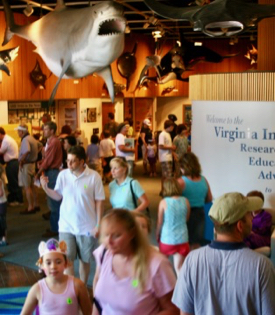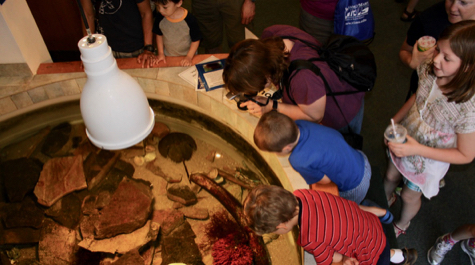Green Fee funds two sustainability projects at VIMS
The William & Mary Committee on Sustainability will support two eco-friendly projects at the Virginia Institute of Marine Science as part of its Spring 2020 Green Fee awards.
Since its establishment in 2008, the W&M Green Fee program has funded more than $1.6 million worth of sustainability-related projects, including 34 projects at VIMS totaling $200,197. The Green Fee advances the W&M Committee on Sustainability’s tripartite goals of teaching, research, and public service. The committee accepts Green Fee proposals every semester.
Educational Exhibit for VIMS Visitors Center
Sally Brooks and Dan Sennett were awarded $5,625 to help create a replica freshwater habitat within an existing aquarium tank in the Visitors Center at VIMS. The exhibit will promote the importance of freshwater habitats in the Chesapeake Bay watershed.
 Brooks, VIMS’ Assistant Director of Advancement—Outreach and Engagement, says “The addition of this exhibit will allow the Visitors Center to expand its displays of habitat types.”
Brooks, VIMS’ Assistant Director of Advancement—Outreach and Engagement, says “The addition of this exhibit will allow the Visitors Center to expand its displays of habitat types.”
Sennett, Marine Aquaculture Specialist at VIMS, adds “It will provide an excellent opportunity to educate visitors about the diversity of plants and animals found throughout the watershed and the importance of water conservation and water quality.”
Surveying Property Owners for Resilient Communities
VIMS Ph.D. student Amanda Guthrie and Research Associate Professor Donna Bilkovic were awarded $5,145 to survey waterfront property owners to better understand what factors they consider when deciding between shoreline armoring (bulkheads, riprap) or living shorelines (planted marshes) to reduce erosion. Managing shoreline erosion is a growing concern among Virginia’s coastal communities due to sea-level rise.
 “In contrast to armoring, living shorelines mitigate erosion, provide other coastal benefits, and can adapt to rising sea levels,” says Guthrie. She will use the survey work as a case study in an upcoming undergraduate seminar course.
“In contrast to armoring, living shorelines mitigate erosion, provide other coastal benefits, and can adapt to rising sea levels,” says Guthrie. She will use the survey work as a case study in an upcoming undergraduate seminar course.
Bilkovic adds “Our survey results will allow us to develop more targeted outreach programs and initiatives hosted through the Center for Coastal Resources Management at VIMS,”
In addition to the pair of projects at VIMS, the Committee on Sustainability supported 5 other projects on W&M’s main campus in Williamsburg, for an award total of $40,180.
Detailed descriptions of this semester’s funded projects, as well as those from earlier funding cycles, are available on the Committee on Sustainability’s Green Fee website.


